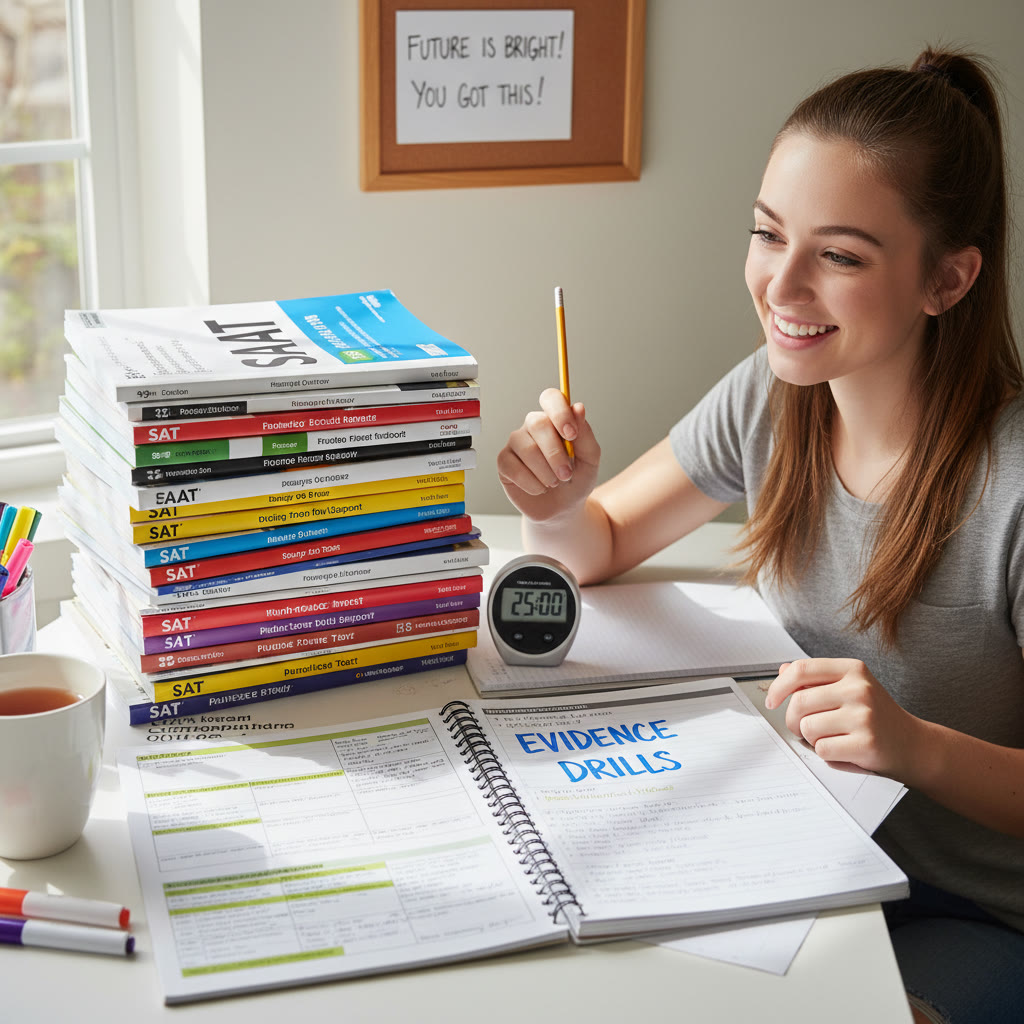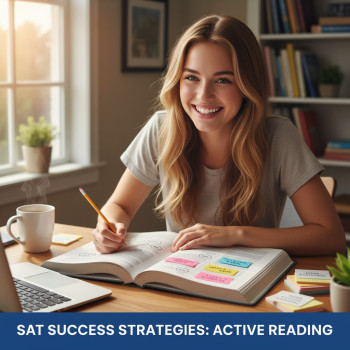Introduction: Why Command of Evidence Feels Like a Different Test
There’s a small moment on the SAT Reading section when everything slows down: you’ve picked an answer to a passage question, and now the test asks you to point to the lines that support it. That moment reveals whether you truly grasp the logic of the passage or whether you relied on a lucky guess. These are Command of Evidence questions, and for many students they’re the deciding factor between a good score and a great one.
If that description makes your stomach flip, take a breath. Command of Evidence questions are teachable, repeatable, and—best of all—practicable. This post walks you through what these questions are, why they trip students up, and, most importantly, how to answer them with clarity and speed. I’ll give concrete strategies, practice drills, a table to clarify common question types, real sample reasoning (original and simple), and a test-day checklist you can use to steady your nerves.
What exactly are Command of Evidence questions?
At their heart, Command of Evidence questions ask you to do two things: 1) identify the best answer to a content or meaning question, and 2) point to the specific part of the passage that supports that answer. They commonly appear as paired items: the first asks a comprehension or interpretation question; the second asks “which choice provides evidence for your answer?” The second item tests your ability to map an abstract answer back to concrete text.
These questions test three skills at once: precise reading, logical mapping, and text-to-answer alignment. You need to recognize not just what the right idea is, but why the passage author would write something that backs that idea up. In short: you must prove your conclusions with the text’s own words.
Why students stumble (and what that reveals)
Command of Evidence feels uniquely cruel because it punishes slippery reasoning. You might choose a correct interpretation but be unable to find lines that actually support it. Or you might find a line that looks right at first glance but, on closer inspection, supports a subtly different point. Here are common reasons students trip up:
- Rushed reading: You skim for a main idea and forget the nuance that changes the evidence you need.
- Answer-first thinking: You pick an answer and then scan for anything that seems to fit, rather than matching the passage to your answer precisely.
- Mixing inference with evidence: Remember, evidence questions ask for textual support, not external knowledge or leaps of logic.
- Over-focusing on keywords: Sometimes a tempting keyword appears in the wrong rhetorical context; the function matters more than the presence of a word.
- Confusing scope: Students point to a single sentence when the evidence is spread across a couple of lines, or they point to a line that supports a minor detail instead of the central claim.
Systematic strategy: a step-by-step approach that works
When you see a Command of Evidence pair, do the following—like a checklist you run through automatically.
- Step 1 — Answer the main question first: Treat the main question like any other reading item. Eliminate wrong choices quickly, and pick the answer you can justify in one or two simple phrases.
- Step 2 — Paraphrase the claim: In a phrase or short clause, write in the margin (or say silently) what the answer is claiming. Keep it tight: “author argues X about Y” or “main character’s mood shifts from A to B.”
- Step 3 — Scan for the region that matches your paraphrase: Look for the argumentative move, transition words, or specific imagery that connects to your answer. Often evidence lives where the author introduces or defends the idea you picked.
- Step 4 — Check scope and tone: Make sure the evidence choice covers the same scope as your answer (not too narrow, not too broad) and that the author’s tone or purpose in those lines matches the claim.
- Step 5 — Eliminate evidence choices precisely: If a choice has a true statement that merely leads to the conclusion or summarizes it without supporting your specific phrasing, eliminate it. The SAT wants direct textual support.
Quick example (short, original, SAT-style)
Passage snippet (imagine a short paragraph): “By the late nineteenth century, railways had knitted regions together, but the same iron tracks also amplified differences. Local producers found new national markets, yet uniform pricing practices squeezed small artisans. The author’s admiration for connectivity is tempered by a worry that the mechanisms of connection can erase local variety.”
Main question: The author’s stance toward the expansion of railways is best described as:
- A. wholly negative
- B. unreservedly positive
- C. cautiously admiring
- D. indifferent
Correct main answer: C — cautiously admiring. Paraphrase: “author admires connectivity but worries about negative side effects.” Now the evidence question asks which lines support that stance.
If one evidence choice points to the sentence about “knitted regions together” only, that’s too positive and misses the worry. If a choice points to the sentence about “uniform pricing practices squeezed small artisans” only, that’s too negative. The correct evidence will point to a combination or the sentence that explicitly shows both admiration and worry — the final sentence in this snippet. That’s the sort of tight mapping you must practice finding.
Common Command of Evidence question types (and how to spot them)
Not all evidence questions are identical. Here’s a quick taxonomy that will help you recognize patterns during the test.
| Question type | What it tests | How to spot it | Best first move |
|---|---|---|---|
| Direct support | Locating the sentence or lines that literally state or paraphrase the answer | Usually points to specific lines or short line ranges | Scan for exact wording and scope |
| Functional evidence | Shows how a sentence functions in the argument (introduce, contrast, conclude) | Look for signal words (however, therefore, thus) | Check whether the line performs the function claimed |
| Inference support | Asks which lines best support an implied conclusion | Often requires reading two sentences together | Test whether the inference logically follows from the lines |
| Contrast or counterpoint | Identifies the author’s use of contrast to frame an argument | Look for shifts in tone or contrasting conjunctions | Choose lines showing the pivot |
Practice drills that build precision
Do ten focused drills a week rather than two hour-long, unfocused sessions. Command of Evidence is a muscle: repetition plus intelligent feedback beats random reading.
- Drill 1 — Two-minute evidence scans: Pick a paragraph, read it carefully for two minutes, then ask a peer or tutor to pose an evidence question. Practice pointing to the smallest passage that still supports the claim.
- Drill 2 — Paraphrase-and-pick: After answering a main question, force yourself to write a one-line paraphrase before looking at evidence answer choices.
- Drill 3 — Reverse engineering: Given a random sentence, invent three possible claims it could support. Then practice eliminating which of those claims the sentence cannot support.
- Drill 4 — Time compression: Once you’re accurate, race to maintain accuracy while shaving seconds off your process.
Weekly practice schedule (example)
| Day | Session focus | Duration |
|---|---|---|
| Monday | Accuracy drills: paraphrase-and-pick | 45 minutes |
| Wednesday | Evidence scans and reverse engineering | 45 minutes |
| Friday | Mixed practice under timed conditions | 60 minutes |
| Weekend | Full Reading section with review | 90 minutes |
Common mistakes and fast corrections
We all make the same errors; the trick is to make fewer of them on test day. Here are the repeat offenders and how to fix them fast.
- Fix: Don’t anchor on a keyword. Mistake: You see a keyword and stop reading. Correction: Check the surrounding clause for the author’s attitude or function.
- Fix: Match scope. Mistake: Choosing lines that mention a detail rather than the claim. Correction: Compare the pronouns, subjects, and time frame; if they differ, the scope is wrong.
- Fix: Eliminate misdirection. Mistake: Choosing a fact the author uses as background. Correction: Ask, “Does this line advance the author’s point, or does it simply set the scene?”
- Fix: Avoid outside knowledge. Mistake: Assuming facts not in passage. Correction: Force yourself to cite textual evidence; if it’s not in the passage, it’s out.
How to read passages to make evidence questions easier
There’s reading before the question and there’s reading for the question. For Command of Evidence, you need both. Try this light annotation routine while you read:
- Mark the thesis or main idea in one short phrase at the top of the passage.
- Note paragraph purpose (introduce, contrast, evidence, conclusion) in the margin with a single letter: I, C, E, or X.
- Underline or circle transition words that signal shifts in argument or emphasis.
- When you encounter examples or a counterargument, bracket them — evidence questions often live where the author defends or rebuts.
These quick habits make locating evidence faster because you’ve already built a map of the passage’s argumentative geography.
Tracking your progress: what to measure
Practice without measurement is guesswork. Track these metrics over time:
- Accuracy on evidence questions (percent correct).
- Average time to answer a paired question (goal: maintain accuracy while reducing time).
- Types of errors (scope, keywords, tone mismatch) so you can target weak spots.
Keep a simple spreadsheet with date, number of evidence questions practiced, accuracy, and dominant error type. Over weeks you’ll see patterns—maybe you’re great at direct support but weak at inference support. That’s where targeted drills help.
Using tutoring and feedback efficiently
Personalized feedback accelerates improvement. A tutor who sees how you think can point out recurring leaps you don’t notice on your own. If you’re using a program like Sparkl’s personalized tutoring, here’s how to get the most out of it:
- Bring specific error data from your practice spreadsheet so sessions target your real problems.
- Ask for modeling: have the tutor walk through their thought process aloud as they choose evidence.
- Request tailored drills and, if available, AI-driven insights that highlight patterns in your mistakes—these can be efficient at identifying hidden habits.
- Use 1-on-1 guidance to simulate test conditions and receive immediate correction on both accuracy and pacing.
Done well, tutoring doesn’t just give answers; it tunes the way you read and argue with the text.
Test-day checklist for Command of Evidence
When the test day arrives, your brain will thank you for a straightforward checklist you can follow without thinking too much.
- Answer the main question first; paraphrase in one short line.
- Only then move to the evidence question and search for lines that map directly to your paraphrase.
- Check scope: pronouns, subjects, and time frame must align.
- Beware of lines that only introduce or summarize; evidence must directly support the claim.
- Keep calm and manage time: if a pair takes too long, mark, move on, and return if time allows.
Final encouragement
Command of Evidence questions may feel like a special challenge, but they reward a small set of repeatable habits. Read actively, paraphrase before you hunt, and match scope with surgical precision. With regular, targeted practice you’ll shrink the time it takes to locate evidence and increase the confidence you bring to every passage.
If you want an extra boost, consider personalized support that focuses on your specific error patterns. Tutors who provide 1-on-1 guidance, tailored study plans, and expert feedback—plus AI-driven insights to catch persistent habits—can accelerate progress without wasting your practice time. When coaching is aligned with the drills above, students often see measurable improvement faster than they expect.


Approach these questions like a detective and an editor at once. Be precise, be skeptical of your own hunches, and let the passage do the proving. With practice—and, when helpful, focused tutoring—you’ll turn Command of Evidence from a stumbling block into a steady source of points.
Go forth, practice smart, and keep a pen ready for the tiny but mighty work of pointing to the text. You’ve got this.
















No Comments
Leave a comment Cancel